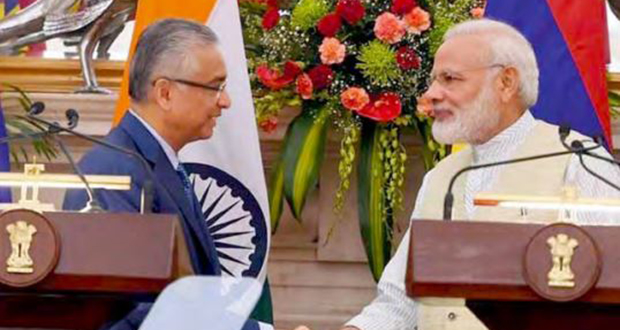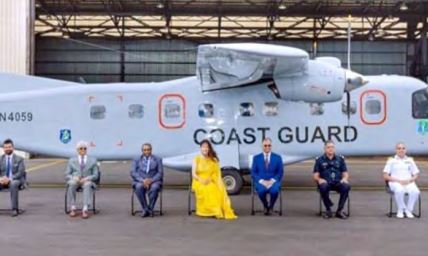Publicité
Dossier: comment les prêts de l’Inde à Maurice ont évolué
Par
Partager cet article
Dossier: comment les prêts de l’Inde à Maurice ont évolué

As the annual budgetary exercise comes up, Prime Minister Pravind Jugnauth has gone on a visit to India. So far, the visit has netted a commitment to help build a traditional medicine facility at Côte-d’Or and local manufacturing of Covid-19 vaccines. For cash-strapped Mauritius, India has emerged as a vital source of development aid and loans. So, how has the aid relationship between Mauritius and India changed over time?
- The first two phases of the relationship
Prime Minister (PM) Pravind Jugnauth has just come back from India. The official visit comes ahead of the annual budgetary exercise, with cashstrapped Mauritius struggling to contain popular anger over rising consumer and fuel prices. During his visit so far, Jugnauth has highlighted how the Indian government has agreed to help set up a centre for traditional medicine at Côte-d’Or as well as local manufacturing of Covid-19 vaccines. “If you look at the history of Mauritius, since the great experiment of the arrival of indentured labourers, so began the relationship between India and Mauritius,” geopolitical strategist Kwang Poon tells l’express.
Milan Meetarbhan, Mauritius’ top diplomat between 2011 and 2015, says that the evolving relationship between Mauritius and India can be roughly divided into three phases. The first phase, he explains, was marked by cultural and historical relations. Despite the fact that since 1974, India has become Mauritius’ security guarantor through a defence pact, and New Delhi has always been wary about who is in power in Mauritius, aid from India to Mauritius was mostly in the cultural sphere. “This was mostly based on common ancestry and common culture,” says Meetarbhan. While economically Mauritius looked westward for its sugar and garment exports, India at this time helped build the Mahatma Gandhi Institute in 1976 and the Indira Gandhi Centre for Indian Culture in 1987. It also ran programmes to train Mauritian civil servants.
The second phase began when, following an economic crisis in 1991, India began opening up its cosseted market and tore down barriers to foreign investments that had been erected by its traditional Nehruvian socialism. “The major turningpoint was when Mauritius emerged as a financial centre,” says Meetarbhan, “roughly speaking, as from 1995, we became the route of choice for others looking to take advantage of the liberalization of the Indian economy and invest there.” Consequently, “many Mauritian professionals started working closely with their Indian counterparts and got to know India and its economy more closely than ever before,” he adds.
With guaranteed exports to Europe coming under threat, financial services dependent on India took on more importance, just as imports from India also started displacing other regional markets such as South Africa, that had dominated Mauritian imports in the 1970s. Imports from India grew from US$206.76 million in 2005- 2006 to $465.51 million in 2020- 2021. Despite amendments in a bilateral double-taxation avoidance agreement in 2016, the Mauritian financial sector was still routing $26.3 billion in foreign investments into India during the first six months of 2021 alone – as compared to a mere $2.9 billion into the whole of Africa. During this time, business predominated in the relationship, and this was reflected in the types of projects that were bankrolled in Mauritius by New Delhi: to take but two examples, the Swami Vivekananda International Convention Centre or the Cybertower in Ébène.
- The Chinese come in…

The year 2007 marked a strategic shift. In July that year, then-prime minister Navin Ramgoolam led a delegation of Mauritian officials and businessmen to China to drum up business there and get Chinese assistance for projects in Mauritius. By that time, China had already emerged as a major trade partner for Mauritius, accounting for over 11 per cent of its total imports. By 2019 it was 16.69 per cent. Following that visit, a slew of Chinese investments and aid began pouring into Mauritius: a projected $820 million in investments to develop the Jin Fei zone over 211 hectares in Terre-Rouge to house up to 40 Chinese companies to start light manufacturing activities in Mauritius; a 195 million euro loan from the Export and Import Bank of China to develop a new airport terminal; $13 million to build new headquarters for the Mauritius Broadcasting Corporation; $4 million to set up a network of 300 CCTV cameras in the north of Mauritius as well as Beijing bankrolling a number of infrastructural works, such as a football stadium, a market, upgrading a hospital (in 2021, China wrote off the 32 million Reminbi Yuan left of 40 million RMB Yuan to help upgrade Victoria Hospital) and low-cost housing projects.
In total, until 2012, the Chinese government had bankrolled at least 47 different projects in Mauritius. In addition to Chinese aid and loans, Chinese companies such as Huawei, Haier and ZTE set up regional headquarters in Mauritius, three Chinese construction companies moved in, and five others got involved in the freeport area. The investments ranged from construction to a $5 million paper recycling plant at La Tour Koenig. While Indian private companies, such as Patel Engineering, tried as from 2010 to fight a rear-guard action to keep India’s business profile in Mauritius through its Neotown project in Les Salines, that (like eventually Jin Fei itself) went nowhere.
“From the Mauritian point of view, we have always been open to the world for business,” says Meetarbhan, “but that is how we in Mauritius were thinking, I am not sure other players looked at all this in the same light.” In other words, India already worried about growing Chinese clout in the region, was fearing that it would be overtaken economically within Mauritius. One example of how Chinese initiative seems to prompt an Indian response when it comes to dealing with Mauritius is the trade pacts that both signed with Mauritius in 2021.
For years the Comprehensive Economic Cooperation and Partnership Agreement (CECPA) between India and Mauritius languished. “This agreement was almost finalized as far back as 2006, but the stumbling block to signing it was always the DTAA which the Indian side insisted on including in that. As a result, that agreement stayed in abeyance for over 15 years,” explains Meetarbhan. Despite Port-Louis agreeing to amend the DTAA in the way that New Delhi wanted in 2016, the CECPA was still slow in coming. Then in October 2019, Mauritius and China signed a free trade agreement that came into effect in January 2021, to coincide with the coming into operation of a continent-wide African free trade agreement. Just after the Mauritian trade pact with China came into effect, in February 2021, India signed the CECPA.
- The Indian come-back…

In response to the growth of Chinese economic clout in Mauritius until 2012, India already wary of Chinese influence in the region, began redefining its relationship with Mauritius. This inaugurated what Meetarbhan has termed to be the third phase of the bilateral relationship; now it transformed itself into a geostrategic relationship. “Just as the US and the UK talk about a special relationship, if India has a special relationship, it’s with Mauritius,” he adds, “but the nature of that relationship changes with the circumstances.”
So as India began asserting its influence in the region in 2015, culminating in its 2016 Security and Growth for All in the Region (SAGAR) strategy, “one element we have to keep in mind is that out of all the major players in the region, India is the only one that is actually a coastal state in the region,” Meetarbhan points out, “so we have to keep that in mind in any analysis of what it does in the region.” If look at the ‘Indo-Pacific’, the Indian Ocean is the key, says Poon, “in the Pacific, it’s basically between China and the US Western coast, but it’s the Indian Ocean where there are a lot of players and strategic chokepoints, such as the Bab el Mandeb, Mozambique, Hormuz and the Malacca straits”.
Mauritius, he adds, is a strategic asset. “Let’s not forget that when the French wanted to invade India, they did so from Mauritius,” says Poon, referring to an attempt by Mahé de La Bourdonnais in 1744 to lead a squad of 3,342 men to invade India via a landing in Madras. It was why the British eventually decided to take Mauritius over in 1810 to help safeguard their Indian holdings. “Just like then, superpower competition is once again converging on the region, and the joker in India’s hands is its relation- ship with Mauritius,” Poon insists, “We have our traditional relationship, but also new aspects that are opening up.” From the point of view of New Delhi, “this geostrategic relation- ship is becoming increasingly important with time,” argues Meetarbhan.
- The pockets open up
India’s attempt to make up for perceived lost ground has seen it more willing to finance the kind of big-ticket infrastructure that Beijing did before. In 2016, New Delhi gave Mauritius a grant of $353 million, the bulk of which ($275 million) for the Metro Express project, with the remaining money split between building a new supreme court building, an ENT hospital, social housing and digital tablets for school students. But they weren’t grants. The following year, in 2017, India offered Mauritius a $500 million line of credit – at 1.8 per cent interest. EXIM Bank of India is putting the money into a special purpose vehicle – SBM (Mauritius) Infrastructure Development Company Ltd (SBMIDC). The government has guaranteed any loan that SBMIDC takes under this line of credit.
What the recent report of the National Audit Office pointed out is that the government borrowed $71 million from this line of credit, but since it technically borrowed it from the SBMIDC – it counts as domestic, not foreign debt. When the government decided to extend the Metro Express into a phase III, India offered another $190 million line of credit, and a grant of $10 million. Just how much of these lines of credit are being used can be seen from the fact that in 2020-2021 alone, $107.5 million out of this line of credit has been used; including $6.7 million borrowed to construct housing at MareTabac and Dagotière by Varindera Construction Ltd; $99 million for Larsen & Toubro’s construction of the Metro Express, $1.2 million for New Age Firefighting Co. Ltd to supply 20 firefighting vehicles and another $93,439 for water pumps.
This is in addition to another $100 million line of credit offered by New Delhi in February 2021 for Mauritius to buy defence equipment. This is not new: Mauritius is a traditional buyer of Indian defence wares, and New Delhi has often helped finance Mauritian arms purchases, offering a $100 million line of credit to Mauritius in 2005, and another $250 million line of credit in 2012. The latest 2021 offer comes as India is attempting to position itself as a defence exporter in the region. “It’s not viable for a small country like Mauritius to equip and maintain an army,” says Poon, “this is why we look to countries like India and France for our security; the Wakashio and a string of incidents since then show how helpful such defence procurements as helicopters can be.”
According to the arms export watchdog SIPRI, between 1990 and 2020, 64 per cent of Mauritian defence purchases were done from India. “While maritime cooperation between the two states goes back a long way, at the beginning we did not have those capabilities, so India helped us,” explains Meetarbhan, “but as India has grown into a regional power, and a big economy with technological capabilities, this relationship has changed. While there is a political dimension to these deals, there is also a commercial one; every country wants to showcase its technology and Mauritius gives an opportunity to advertise to other potential markets.”
Under the $100 million line of credit, so far Mauritius has bought a Dhruv helicopter which the government was looking to buy for $26 million. But how much Mauritius actually benefits can be seen from the fact that the audit report lamented that the one Dhruv helicopter the government had, was not really being used for 362 days in a three-year period. The rest of the line of credit being used to buy a Dornier plane in April this year to replace one that was bought in 1990 for $6 million. But which was costing the government $11,000 per year to maintain and on which it had spent $7.75 million for an upgrade between December 2018 and May 2019.
This enthusiasm for opening up the purse strings to this extent, however, is a relatively recent development. And it only came after New Delhi was spooked by what it perceived to be Beijing’s growing clout in Mauritius – as well as New Delhi’s pushing for Mauritius to align with it geo-strategically in its competition with China in the region through the Agalega facility in 2015, or turning Mauritius into a member of its Colombo Conclave.
According to India’s ministry of External affairs, between 2001 and 2021, India has offered Mauritius a total of $954.8 million in lines of credit, out of which at least $600 million have come only after 2016. And only after India started thinking strategically about the region. The question now is, with a heavily indebted Mauritius having to come up with a new Budget soon, what kind of help could the PM get in his latest trip to New Delhi.
Publicité
Publicité
Les plus récents






